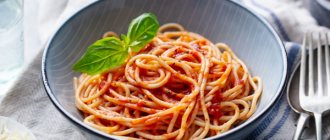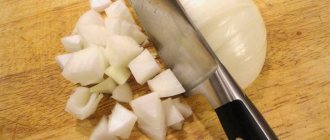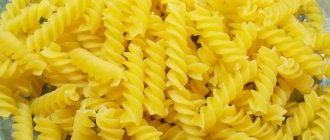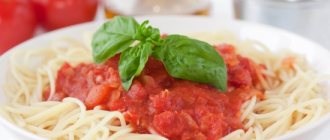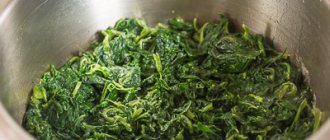What is the fundamental difference between ketchup and tomato paste? They are prepared from the same tomatoes, but they are two completely different products. Ketchup is a sauce consisting of several components. And tomato paste is a valuable ingredient, the basis of many dishes, including a variety of sauces. Therefore, replacing it with ketchup is incorrect. But on the contrary - it is possible! In which cases it is better to use paste instead of ketchup, and in which cases you should not do this, we will tell you in our article.
Only tomatoes and nothing extra in the composition
Tomato paste can rightfully be considered the most natural product. After all, it contains only two components – tomatoes and salt. Briefly, the paste production process looks like this: tomatoes are carefully sorted, peeled and seeds are removed (which, by the way, are used as seeds for seedlings), crushed, and then boiled until a homogeneous mass is formed. The result is a tasty and healthy paste, which is subsequently either sent to retail chains or becomes the basis for derivative products. The absence of impurities is an important argument in favor of tomato paste.
But ketchup has a richer composition. That’s why there are more questions, for example, among those who are on a diet. The composition of ketchup depends on its marking according to GOST. Extra class ketchup must contain at least 40% tomato paste; any flavoring additives are not allowed. A sauce of the highest category must contain at least 20% tomato paste, and its composition may already contain stabilizers, thickeners, and flavorings. Fruit or vegetable purees, as well as a large number of spices and flavorings, can be added to a product labeled “first category” The content of tomato paste in this ketchup is at least 18%. The “second category” boasts only 14% of tomato paste. However, this does not mean that this ketchup is bad; it is also approved by GOST. Here the choice is entirely up to the consumer.
Health benefits even when cooked
Despite the fact that the tomatoes undergo heat treatment, almost the full composition of vitamins and minerals remains in the tomato paste. And valuable lycopene, which helps in the prevention of oncology, becomes 10 times more valuable during heat treatment! So, in this regard, pasta is even healthier than fresh tomatoes.
The paste is rich in vitamin C (100 grams is half the daily value), contains B vitamins, as well as A, E, PP, K. They are useful for maintaining body tone and strengthening the immune system, helping the functioning of the circulatory system, normalizing the production of hormones and cholesterol.
The amount of minerals in tomato paste is also impressive:
- Phosphorus plays an important role in metabolic processes.
- Zinc has a beneficial effect on the condition of skin cells and strengthens hair.
- Magnesium is needed to maintain the functioning of the muscular and nervous systems.
- Potassium removes excess fluid and is beneficial for the cardiovascular system.
- Iron prevents the development of anemia.
Fresh tomatoes
In the summer, housewives who have their own plot next to their house never use tomato paste. They replace it with fresh tomatoes. The method is also suitable for those who live in the city, because ripe tomatoes grown in garden beds appear on the market. They are fragrant and juicy. It is these vegetables that contain the greatest amount of vitamins.
Tomato paste in any food industry is prepared from ground tomatoes. Some people manage to add applesauce or beets, but then the name does not correspond to the contents of the jar. To get an equivalent substitute for a quality product at home, you need to have tomatoes. You can use those that are overripe and cracked. The main thing is that they do not turn out to be rotten. And everything is done extremely simply:
Homemade tomato paste made from fresh tomatoes can be used immediately or after cooling. It can be stored in the refrigerator in a hermetically sealed container for 2-3 days.
To add according to the recipe, you need to take about 2-3 times more than indicated, although it is best to go by taste.
Rich taste and real savings
Since the concentration of tomatoes in the paste is an order of magnitude higher, its taste is much brighter than that of ketchup. For example, it is enough to add just one tablespoon of paste to a vegetable stew, while you will need to add much more ketchup. And their taste is different: paste has a rich tomato taste, while ketchup has a vinegary sourness.
Even in comparison with natural tomatoes, pasta can win. The fact is that fresh vegetables are very watery, and excess moisture can ruin the dish. Whereas a couple of teaspoons of paste will completely transform the taste without compromising the consistency.
Versatile fighter: can become ketchup and juice
Tomato paste is also good for its versatility: it can be an independent product, and if necessary, it can easily be turned into ketchup or even tomato juice. They are easy to prepare at home.
Tomato paste ketchup recipe
Ingredients:
- tomato paste – 400 g,
- water – 2 glasses,
- salt – 1 tsp,
- sugar – 3–4 tsp,
- garlic – 2–4 cloves, to taste,
- apple cider vinegar – 1 tsp,
- dill and parsley - to taste.
Place the tomato paste in a saucepan and, stirring, gradually pour in water until it reaches the desired consistency. Add spices and sugar. Then place on the stove and stir constantly until the mixture boils.
After the ketchup begins to boil, add chopped herbs and garlic. Cook for 5 minutes over medium heat, remembering to stir. To better preserve the product, you need to add vinegar at the end of cooking.
Soy sauce
This seasoning is most often used by sushi lovers. It adds flavor to the dish. To avoid the negative consequences of consuming soy sauce due to its high salt and sugar content, do not use it in excessive quantities. Nutritionists recommend replacing it with Bragg's or coconut liquid amino acids, which are healthier alternatives. The former are made from natural soybeans, have a natural salty taste due to minerals, and do not contain sodium. Coconut amino acids are coconut sap mixed with mineral sea salt. Both sauces are used as seasonings for rice and seafood.
How to make tomato juice from tomato paste
Tomato juice is produced in factories from concentrated paste, but it is not difficult to prepare at home. The recipe for this juice has been known to many since childhood: just mix tomato paste with cold drinking water in a ratio of 1:3 and add salt to taste, or simply add 1 to 3 tablespoons of paste to a glass of water (depending on the thickness and richness of the drink you want to receive). The main thing is to choose quality pasta.
Here's a quick reminder of what to look for when buying tomato paste.
Cooking technology
Pour vegetable oil into a frying pan to fry the meat pieces. Warm it up thoroughly. Cut the washed and dried meat into medium cubes and fill the frying pan with these cubes.
Fry the meat until it is covered with a golden brown crust on all sides. Don't forget to stir it so it doesn't burn. At this stage of cooking, it is permissible to add a little salt to it.
Take a second frying pan and fry two tablespoons of flour in it until brown. We do not grease the frying pan with anything - we prepare the flour using dry dishes. Pour the finished flour into the meat and continue preparing pork goulash without tomato paste.
To do this, peel the onion and carrot. Chop the vegetables. We rub the carrots through a grater of any fraction, and cut the onion as you like. But usually the onions in goulash are cut into small cubes.
Sauté the prepared vegetables in vegetable oil until they are soft and the onions are golden.
How to choose quality tomato paste
- A good tomato paste should be thick and uniform in structure, without lumps or air bubbles.
- The color of the correct paste is red with a reddish tint. Bright red or even burgundy paste may contain dyes.
- The paste should contain nothing but tomatoes and salt. Read the label carefully: avoid products that contain flavor enhancers, dyes, starch and preservatives.
- To check whether there is starch in the paste, drop a couple of drops of iodine into it: if it is added, the paste will turn blue.
- The shelf life of the paste in a glass jar is up to 2 years. Metal cans of tomato paste protect it from light, but they have a shorter shelf life of a year.
Tomato puree
In fact, tomato puree and paste are very similar in composition because they are made from tomatoes that have been peeled and seeded. They are necessarily subjected to heat treatment, but the paste is evaporated longer, so it turns out thicker and more concentrated. Their color is also not the same: the puree will be much lighter.
If you decide to add puree to a recipe instead of tomato paste, you will have to increase the amount slightly. The puree is perfect for adding to pasta, rice, pizza, goulash, stir fry and even borscht.
Sometimes adding puree changes the consistency of the dish; after all, it is much waterier than paste. To avoid such incidents, you can boil the substitute product separately so that part of the liquid boils away. Considering that in most dishes where pasta is added, there is water, its amount can be reduced. Then everything will quickly fall into place.
And one argument against
Despite all the benefits of tomato paste, ketchup fans will not exchange their favorite sauce for anything. After all, unlike pasta, it can have completely different flavors: pungency, sourness, sweetness, the aroma of herbs or vegetables. Some people like thick ketchup, close in consistency to tomato paste, while others like translucent liquid ketchup with an unobtrusive taste.
The popularity of fast food also has its effect: ketchup is presented in every fast food chain and is combined with snacks, chips and potatoes. Compact, convenient packaging and long shelf life make it a permanent resident of most refrigerators. That's why it remains one of the most popular sauces in the world, and gourmets are in no hurry to give it up.
However, this “minus” still does not outweigh the overall benefits of tomato paste, the taste of which can also be experimented with at home if desired.
What do you say?
Expiration date is more expensive
Increasing the shelf life of products is one of the priorities in the work of any manufacturer. Usually, there are several ways to ensure that a product stays on store shelves for as long as possible and does not spoil.
The simplest of them is to include chemical preservatives in the product: benzoic and/or sorbic acid. But this is far from the only way, and in the case of ketchup, it is possible to abandon preservatives. For this, for example, it is necessary to use sterilization technology. It is more expensive, but this production method increases the shelf life of products as effectively as preservatives. According to the results of the examination, ten products contained preservatives: “My Family”, “Maheev”, “What You Need!”, ARO, Fine Life, “D”, “Tomasko”, “Red Price”, “365 Days”, “ Our product."
A deception label? Products whose labeling contains advertising gimmicks Read more
